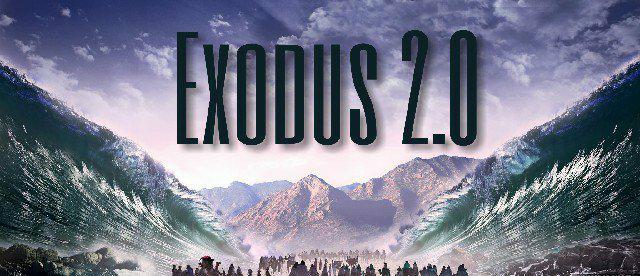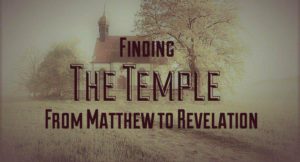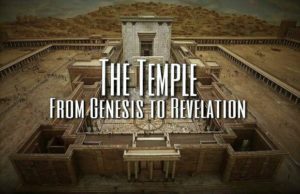Lesson 3 was the Old Testament prequel to this study in the New Testament about the Exodus. Last week’s lesson introduced the fact that Egypt became a national symbol of exile and bondage for Israel, and Exodus imagery was used by the prophets to relate how the Messiah would redeem Israel. That study ended with the statement, “(Jesus) leads the people through a new exodus which consummates with His death on the ‘cross’ of the Red Sea.” Such a statement needs evidence. Lesson 4 is here to help you find the Exodus from Matthew to Revelation.
Finding Egypt in the New Testament– If Egypt is a symbol of exile and bondage (slavery to sin), and Jesus is going to perform a new, redemptive Exodus in the New Testament, then we should expect to find imagery of Egypt in the New Testament. We find Egypt no later than the second chapter of Matthew. In Matthew 2:13, Jesus is taken by His parents to Egypt to escape the baby massacre by King Herod. In verse 15, Matthew quotes Hosea 11:1 and applies the prophecy to Jesus, “Out of Egypt I called My Son.” Interestingly, Hosea originally speaks of Israel when he says, “My Son.” The natural conclusion is this- Jesus is reenacting Israel’s history. Just like Israel was in Egypt in their beginnings, so Jesus is in Egypt. Thus, we should expect Jesus to mimic Israel and Moses further, until the story of Jesus culminates in leading an exodus out of Egypt, the slave bonds of sin. In response to the Jews who said they had never been in slave bondage, Jesus differed by saying,
“Whoever commits sin is a slave of sin. And a slave does not abide in the house forever, but a son abides forever. Therefore, if the Son makes you free, you shall be free indeed,” (8:34-36)
If you understand that Egypt meant the same thing as slavery to a Jew, and Messiah was prophesied to lead His people out of slavery, then the double meaning of Jesus’ words come to life here. Jesus says He will deliver His people through Exodus from the slavery of Egypt. “The truth shall make you free!” (John 8:32).
Finding the Passover Lamb in the New Testament– The scene is set as Jesus appears in Egypt where His people are in slavery. But before there can be an Exodus, there must be a Passover. Now remember from Exodus 12, what do you need for a Passover supper? “The next day John saw Jesus coming toward him, and said, ‘Behold! The Lamb of God who takes away the sin of the world!” (John 1:29). Isaiah said the Messiah would be, “As a lamb led to the slaughter,” (53:7). Jesus is the Passover lamb all the way from Matthew to Revelation (see Rev. 5:6-14 & 21:22 – 22:3). It should be no surprise then, when we see Jesus eating the Passover with His disciples in John 13:1-2, right before the new Exodus will occur. John simply reports they ate the Passover. Luke fills in Jesus saying, “With fervent desire I have desired to eat this Passover with you before I suffer; for I say to you, I will no longer eat of it until it is fulfilled in the kingdom of God,” (22:15-16). Then back to John, who leaves no doubt as to what Jesus meant. John quotes an instruction from Exodus 12:46 about the Passover lamb and applies it to Jesus hanging on the cross, “For these things were done that the Scripture should be fulfilled, ‘Not one of His bones shall be broken,'” (John 19:36).
Finding the Red Sea in the New Testament- So Jesus is in Egypt at the beginning of the gospels, and He is portrayed as a Passover lamb as He dies on the cross. I can sense you are still confused and asking the question, “But when did Jesus actually perform the Exodus?” I’ve subtly answered that question already. Nonetheless, if you can’t see the answer yet, allow these images of Paul to help identify at what point in time Jesus led this new Exodus.
“Do you not know that as many of us as were baptized into Christ Jesus were baptized into His death? Therefore we were buried with Him through baptism into death, that just as Christ was raised from the dead by the glory of the Father, even so we also should walk in newness of life.” (Romans 6:3-4)
Baptism is here described as a reenactment of Jesus’ death, burial, and resurrection unto life. When a sinner is buried in water, his sins are washed away in the Red Sea (as it were), and he arises out of the water to walk as a ransomed new creation in the wilderness of this world. When Jesus died is when He led His new Exodus. When we are baptized is when we partake in that new Exodus. If this is not clear enough, read a stronger parallel passage,
“Moreover, brethren, I do not want you to be unaware that all our fathers were under the cloud, all passed through the sea, all were baptized into Moses in the cloud and in the sea…” (1 Corinthians 10:1-2)
By comparing Romans 6:3-4 with 1 Corinthians 10:1-2, we understand without a shadow of doubt: Jesus performed a new Exodus when He died, and we have to be baptized in water like the Israelites in order to experience Exodus from sin.
Conclusion- There are many more parallel details in the New Testament that help the Bible reader realize this new Exodus fulfilled in Jesus Christ. Read the gospels with rapt attention, and you will notice details in stories such as the baptism of Jesus, in Matthew 3:13-17, that beg you to see Jesus’ actions as preparatory of a new Exodus. You cannot appreciate the New Testament without a foundation in the Old Testament. Hopefully, these past three Five Minute Bible Studies answering, “What’s Going on From Genesis to Revelation,” have helped you understand that truth. Log on next week as we study, “Finding the Temple from Genesis to Revelation.“




Comments
Pingback: 2nd Exodus on PPH! – POWER OF PRETERISM